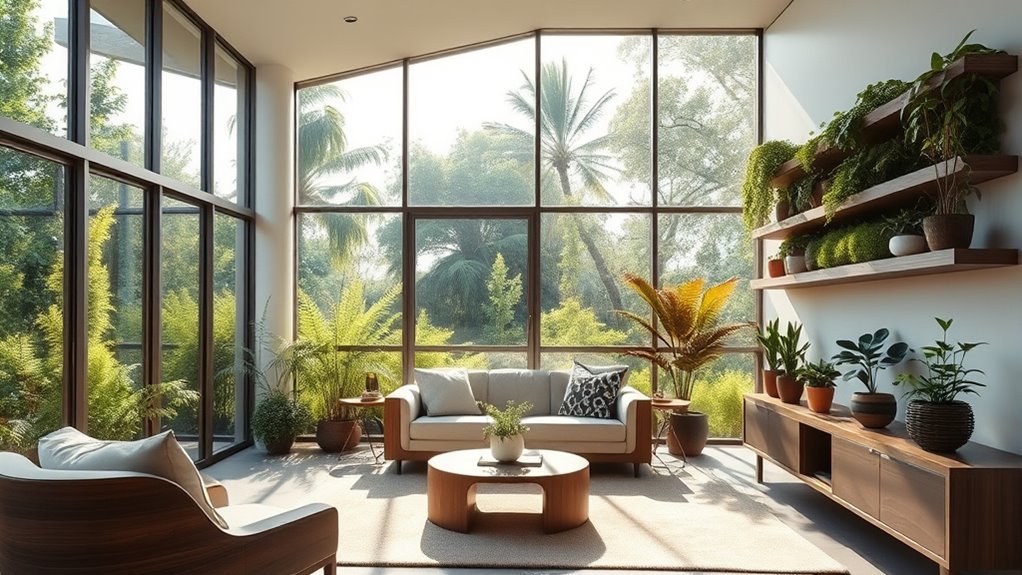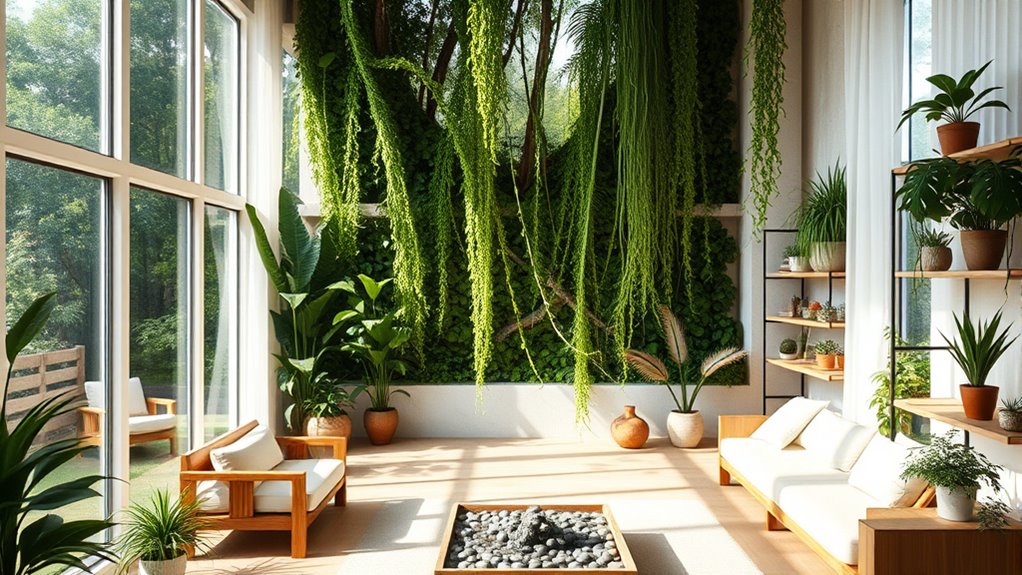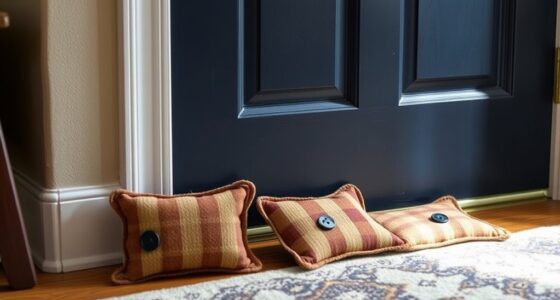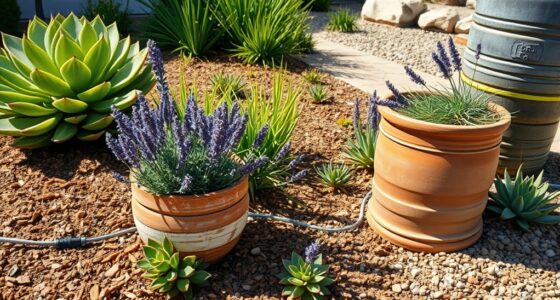Biophilic design brings natural elements like plants and sunlight into your indoor spaces, creating a healthier and more inviting environment. You can enjoy increased well-being, better air quality, and a calming atmosphere that boosts your productivity and mood. Incorporating indoor gardens and maximizing natural light help you feel more connected to nature throughout your day. Keep exploring to learn how these design choices can transform your space into a nurturing sanctuary.
Key Takeaways
- Integrates natural elements like plants and water features into indoor spaces to enhance well-being.
- Uses ample natural light and views of the outdoors to create a more inviting environment.
- Incorporates indoor gardens to improve air quality and promote mental relaxation.
- Fosters a connection with nature to reduce stress and boost productivity.
- Creates tranquil, nurturing spaces that support physical and mental health through biophilic principles.

Biophilic design is a thoughtful approach that integrates natural elements into built environments to enhance well-being and productivity. When you incorporate features like indoor gardens and maximize natural light, you create spaces that feel more alive and inviting. Indoor gardens serve as vibrant focal points, bringing a splash of greenery indoors and providing a calming visual break from daily routines. They don’t have to be elaborate; even small potted plants or a vertical garden can make a significant difference. These green elements not only improve air quality but also foster a sense of connection with nature, which can reduce stress and boost overall happiness.
Maximizing natural light plays a vital role in biophilic design. When your space is flooded with sunlight, it helps regulate your body’s internal clock, improving your sleep-wake cycle and elevating your mood. Large windows, skylights, and open layouts are effective ways to invite more sunlight inside. As you let natural light pour in, you reduce your reliance on artificial lighting, which can often be harsh and draining. The warmth and glow of natural light make your environment feel more open and welcoming, encouraging you to spend more time in your space and feel energized.
You can combine indoor gardens with natural light to create a truly restorative setting. Position your plants near windows or under skylights where they’ll thrive and flourish. This integration not only enhances the aesthetics but also improves your indoor air quality, as plants absorb pollutants and release oxygen. As you tend to your indoor garden, you’ll notice how caring for these plants becomes a mindful activity that grounds you and promotes mental clarity. Additionally, using wireless headphones can help you enjoy music or guided meditations while tending to your plants without disturbing others.
In addition to the visual benefits, natural light and indoor gardens contribute to a healthier environment. They help regulate humidity levels, reduce noise pollution, and create a sense of tranquility that supports mental health. When you design your space with these elements in mind, you foster a positive atmosphere that encourages focus, relaxation, and creativity. Whether you’re working from home, relaxing in your living room, or redesigning an office, integrating indoor gardens and maximizing natural light transforms your environment into a nurturing sanctuary. It’s about bringing the outdoors inside in a way that nurtures your body and mind, making every day feel more vibrant and balanced.
Frequently Asked Questions
How Does Biophilic Design Impact Indoor Air Quality?
You might wonder how indoor air quality improves, and biophilic design plays a key role. It enhances air circulation, helping pollutants disperse and exit more efficiently. Plus, incorporating natural elements like plants can actively remove pollutants from the air, making your environment healthier. By promoting better airflow and natural filtration, biophilic design creates a fresher, cleaner indoor space, benefiting your overall well-being.
Can Biophilic Design Reduce Stress Levels Effectively?
You can profoundly reduce stress levels through a strong nature connection, which is a key aspect of biophilic design. By integrating natural elements like plants, natural light, and views of the outdoors, you create a calming environment that promotes stress reduction. This connection to nature helps lower cortisol levels and enhances your overall well-being, making your indoor space feel more soothing and restorative.
What Are Affordable Ways to Incorporate Biophilic Elements?
You can easily incorporate biophilic elements on a budget by adding greenery like low-cost houseplants or succulents. Use DIY natural decor, such as creating your own plant hangers or using recycled materials for planters. Place plants near windows for natural light and keep them healthy with minimal effort. These simple, affordable steps help bring nature indoors, reducing stress and creating a calming environment without breaking the bank.
How Does Biophilic Design Influence Mental Health?
Imagine a Victorian garden in your living room—biophilic design boosts your mental health by strengthening your nature connection. It reduces stress, enhances emotional well-being, and increases focus. By incorporating natural elements like plants, sunlight, and water features, you create a calming environment that supports your mental resilience. This approach fosters tranquility, making everyday spaces more restorative and helping you feel more balanced and energized.
Are There Specific Plants Best Suited for Indoor Environments?
When choosing indoor plants, you want low-maintenance greenery that thrives with minimal care. Look for species like snake plants, pothos, or ZZ plants, which are perfect for indoor environments. They’re easy to care for, tolerate low light, and require infrequent watering. Focusing on indoor plant care guarantees your plants stay healthy and vibrant, creating a calming atmosphere that enhances your space without demanding too much effort.
Conclusion
Imagine stepping into a room where sunlight streams through lush greenery, instantly calming your mind. That’s the power of biophilic design—you bring nature’s tranquility indoors, transforming your space into a sanctuary. Just like a garden nourishes a weary soul, incorporating natural elements can boost your well-being and creativity. Embrace this approach, and you’ll discover that your home becomes not just a place to live, but a vibrant oasis that revitalizes your spirit every day.









